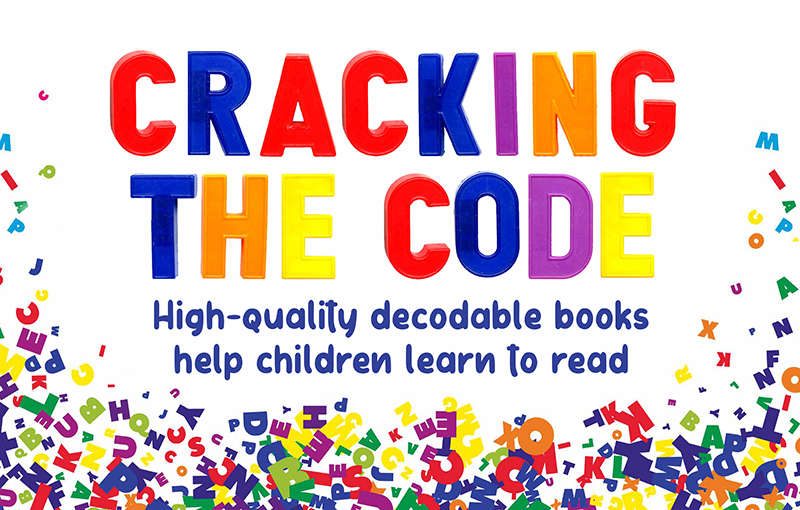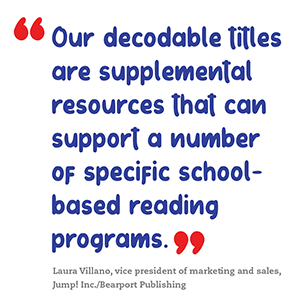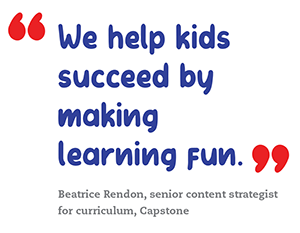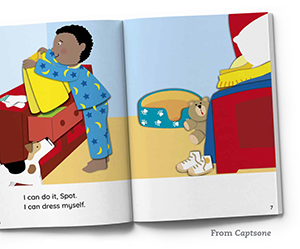Cracking the Code: High-Quality Decodable Books Help Children Learn To Read
Decodables, or simple books written for beginning readers, have become staples in elementary school classrooms and libraries everywhere, and for good reason. By encouraging children to sound out words using decoding strategies rather than guessing from pictures or predicting from other cues, decodables help emergent readers learn to read independently.


Decodables, or simple books written for beginning readers, have become staples in elementary school classrooms and libraries everywhere, and for good reason. By encouraging children to sound out words using decoding strategies rather than guessing from pictures or predicting from other cues, decodables help emergent readers learn to read independently—allowing them to build confidence in their skills as they string together connected text.
Decodable books are sequential in nature and build phonic knowledge gradually, developing the foundational skills that children need for independent reading. This is critical, especially as assessments show more students are struggling with reading skills. The 2022 National Assessment of Educational Progress (The Nation’s Report Card) showed a decline in reading skills among both fourth and eighth graders.
“Literacy skills have dropped since COVID,” says Robb Watts, managing director of Knowledge Books and Software. If these skills gaps aren’t addressed, he says, “children will go on to lack confidence as adults.” People with poor literacy skills are more likely to struggle with poverty, poor health, and even incarceration, the nonprofit Lucy Project notes.
Decodables play a key role in preventing this from happening and putting students on a path toward success. A good set of decodable books will introduce new phonics concepts in a systematic and deliberate way, with a carefully constructed scope and sequence in which the skills that students learn build cumulatively. Most of the words in the books should be decodable, and the books should be engaging for young readers.
Here are some of the latest decodable series intended for school libraries and classrooms.
Cherry Lake Publishing Group
Based in Ann Arbor, Michigan, Cherry Lake is a publisher of award-winning children’s books for the home, schools, and libraries, from decodables and early readers through picture books, chapter books, and graphic novels.
The company’s Cherry Blossom Press imprint offers two main decodable series: “Little Blossom Stories,” ISBN 9781668937105, which are stand-alone fiction stories with an authentic narrative arc, and “In Bloom,” ISBN 9781668938447, which are decodable chapter books.
“Little Blossom Stories” are 16-page books that include sequenced sound/spelling patterns, a repetition of sight words, and comprehensive keyword lists in the back to support teaching. There are 159 titles in the series, including 12 new titles for spring 2024.
The books are based on a color-coded scope and sequence for easy reference, with the following progression: Light blue: short vowels; Dark blue: consonant blends; Lilac: consonant digraphs; Purple: silent “e”; Pink: vowel teams; Red: “r”-controlled vowels; Fuchsia: diphthongs; Orange: syllables.
 “In Bloom” books are a little longer, 24 pages, and they come in a larger format with paperback or library bindings. These books offer the next step in reading for second and third graders who still need to practice fundamental reading skills or for younger readers ready for longer stories, says Editorial Director Amanda Gebhardt. Forty titles are available now, with 10 more scheduled for publication in fall 2024.
“In Bloom” books are a little longer, 24 pages, and they come in a larger format with paperback or library bindings. These books offer the next step in reading for second and third graders who still need to practice fundamental reading skills or for younger readers ready for longer stories, says Editorial Director Amanda Gebhardt. Forty titles are available now, with 10 more scheduled for publication in fall 2024.
Both series were created by Cecilia Minden, former director of the Language and Literacy Program at the Harvard Graduate School of Education. Elizabeth Scully, an active reading specialist and Minden’s former student, wrote some of the “In Bloom” books as well.
“We’ve worked really hard to make beautiful, narrative-driven skills books that are simple to use and fit within any phonics-based curriculum,” Gebhardt says. “We’re also proud of the variety that we offer: Students and teachers get to choose from among many titles for each skill.”
In addition to these fiction-based decodables, Cherry Blossom also offers two nonfiction-based decodable series: “Little Math Stories,” August 2023, ISBN 9781668926659, which cover kindergarten and first-grade math standards such as counting and sorting using decodable text; and “Little Science Stories,” January 2024, ISBN 9781668937143, which introduce children to early science concepts. There are eight books in each nonfiction series.
The books help students learn and practice basic reading skills as they also learn math and science concepts, Gebhardt says, “so they can engage independently with the content right away.”
Jump! Inc./Bearport Publishing
Founded in 2012, Minneapolis-based children’s publisher Jump! is dedicated to improving early literacy and instilling a lifelong love of learning. The company’s curriculum-aligned children’s books for prekindergarten through fifth grade combine vibrant colors, captivating design, high-interest topics, and carefully leveled text to engage young readers.
Jump! strives for diversity and inclusion, showing people in its books at every age, from all ethnicities, and with varying abilities. In addition, the company takes great care to avoid showing children and adults in stereotypical gender roles. This effort helps ensure that readers see themselves and others as equal members of their communities.
In 2019, Jump! acquired Bearport Publishing, an award-winning publisher of high-interest books for grades K-8, mostly nonfiction. Jump! and Bearport offer decodable books that complement each other nicely.
“Decodables by Jump!,” ISBN 9798892134729, is a series of 115 nonfiction titles across 12 reading levels. Bearport’s “Supersonic Phonics” series, ISBN 9798888226711, includes 166 narrative-based decodable fiction titles across 13 reading levels. Both series include content aimed at students in prekindergarten through fourth grade and are available in reinforced library binding, paperback, and ebook formats.
“Decodables by Jump!” cover high-interest nonfiction topics such as habitats, the solar system, bugs, and trains. These 16- and 24-page books feature full-color photos from real life designed to engage young readers who are curious about the world.
“Supersonic Phonics” books feature fun, quirky stories and illustrations designed to engage young readers, with titles such as Lorna Starts Classes, The Elf with Ear Hair, and Bawdy McPea’s Circus of Fleas. Most of the titles are 32 pages in length, but the titles at the upper range of complexity are 40 and 48 pages long.
 Both series follow the same color-coded sequence of skills, providing a consistent and structured approach that helps guide reading instruction. As children move through the color bands, the sentence structure complexity advances at a rate that supports their skills development and reading confidence. The color-coded reading levels are also aligned with Lexile levels for easy reference.
Both series follow the same color-coded sequence of skills, providing a consistent and structured approach that helps guide reading instruction. As children move through the color bands, the sentence structure complexity advances at a rate that supports their skills development and reading confidence. The color-coded reading levels are also aligned with Lexile levels for easy reference.
Using color-coded bands to indicate a book’s reading level makes it less obvious to students how they compare with their peers, says Laura Villano, vice president of marketing and sales. She adds, “Teachers and librarians have told us they really appreciate that.”
As an alternative to purchasing the entire series, educators and librarians can buy individual titles or reading-level sets.
Apart from offering fun, quirky, and high-interest content that kids will want to read, another thing that differentiates the company’s decodable books is the amount of supporting materials  that accompany them, Villano says. For instance, each title includes downloadable teacher and parent resources to help engage kids in a book and extend their learning. These resources consist of comprehension questions, reading prompts, and multisensory activities, such as having children trace the shape of the letters they’re learning about.
that accompany them, Villano says. For instance, each title includes downloadable teacher and parent resources to help engage kids in a book and extend their learning. These resources consist of comprehension questions, reading prompts, and multisensory activities, such as having children trace the shape of the letters they’re learning about.
Jump! and Bearport also provide correlations that show how their decodable titles fit into many of the leading phonics-based programs used in schools. “Our decodable titles are supplemental resources that can support a number of specific school-based reading programs,” Villano explains.
Capstone
Based in Minneapolis, Capstone publishes educational content for students in grades K-5, including children’s books, literacy programs, interactive ebooks, and the award-winning PebbleGo™ digital-learning platform for schools.
 Capstone initially produced books for students who struggled to read. While its focus has broadened, the company still brings a high-interest approach to everything it publishes. “We help kids succeed by making learning fun,” says Beatrice Rendon, senior content strategist for curriculum.
Capstone initially produced books for students who struggled to read. While its focus has broadened, the company still brings a high-interest approach to everything it publishes. “We help kids succeed by making learning fun,” says Beatrice Rendon, senior content strategist for curriculum.
"Stairway Decodables" is a new series of 60 books intended to help children learn reading fundamentals. Capstone is publishing 36 titles in the series in March 2024 and another 24 titles in August 2024. “By August first, we’ll have hardcover, paperback, and ebook versions available for each of the 60 titles,” Rendon says.
Stairway Decodables are grouped according to the six steps in the scope and sequence that Capstone has developed for teaching kids how to decode text.
 Step 1 focuses on short vowel sounds, and an example is Tess Has Fun by Leanna Koch, illustrated by Roberta Collier-Morales, March 2024, ISBN 9781484697931. Step 2 focuses on consonant blends, and the books include Finn Swims by Leanna Koch, illustrated by Sara Schultz, March 2024, ISBN 9780756583972. Step 3 focuses on consonant digraphs, or two-letter combinations that make a single sound. An example is Beth’s Bath by Leanna Koch, illustrated by Hye Won Yi, March 2024, ISBN 9780756583224.
Step 1 focuses on short vowel sounds, and an example is Tess Has Fun by Leanna Koch, illustrated by Roberta Collier-Morales, March 2024, ISBN 9781484697931. Step 2 focuses on consonant blends, and the books include Finn Swims by Leanna Koch, illustrated by Sara Schultz, March 2024, ISBN 9780756583972. Step 3 focuses on consonant digraphs, or two-letter combinations that make a single sound. An example is Beth’s Bath by Leanna Koch, illustrated by Hye Won Yi, March 2024, ISBN 9780756583224.
Step 4 covers silent “e,” soft “c” and “g,” and trigraphs with books such as Will’s Bike by Leanna Koch, illustrated by Andrew Rowland, March 2024, ISBN 9780756583644. Step 5 covers vowel teams, or sets of two vowels that make one sound, with books like Cat Food Clues by Leanna Koch, illustrated by Mike Byrne, March 2024, ISBN 9781484698204. Step 6 teaches vowel-“r” combinations, diphthongs, and long vowels. The books include Points and Fouls by Leanna Koch, illustrated by Evelyne Duverne, March 2024, ISBN 9781484698730.
Each book is from 24 to 32 pages long and includes a minimum of 80 percent decodable text. Featuring plots and recurring characters sure to appeal to young children, the books are “fun to read and inviting,” says Vice President of Publishing Beth Brezenoff. For example, in Cat Food Clues, Dot’s cat food keeps mysteriously disappearing—and her owner and friends must put clues together to solve the mystery.
“We’re teaching children how to read, but they’re also getting a fun story,” Brezenoff says.
The front cover of each book notes the specific step and skills covered in that title, so teachers, librarians, and other caregivers can see immediately which books are appropriate for each young reader. All the books follow the same structure and include a list of key vocabulary words, as well as discussion questions, phonemic-awareness activities, writing prompts, and other extension ideas.
The series was designed to supplement any phonics-based curriculum that a school might be using, and caregivers don’t need to be licensed instructors to guide young readers through these highly accessible titles.
“Our hope is that, regardless of what the core instruction might look like in a given classroom, these books will fit nicely alongside that instruction and provide the extra decoding practice that kids need for success,” Rendon says.
Norwood House Press
Norwood House Press was established in 2005 in Norwood Park, a neighborhood of Chicago. Today, the company offers more than 2,000 titles for K-8 libraries and classrooms. Its mission is to produce informational and fiction books that help kids learn and excel in school and life. Last year, Norwood House Press was acquired by Rosen Publishing Group.
Released in August 2023, “The Decodables” is a series of 52 titles broken into six sets of books that use the Science of Reading to help children acquire decoding and word-recognition skills. Developed in consultation with literacy coach Emily Nudds and available in hardcover, paperback, and ebook versions, the books are cumulative, allowing young readers to learn new skills while reviewing previously taught ones.
Set 1, "Search for Sounds," ISBN 9781684500031, contains eight books that introduce children to letter sounds, with books such as Wonderful Weather and Come to the Farm. Set 2, "Friends and Family Fun," ISBN 9781684500048, contains 12 books that introduce children to consonant-vowel-consonant patterns, with titles such as Sam Naps and Ben Gets a Pet. Set 3, "Things We Like to Do," ISBN 9781684500055, features eight books that introduce consonant blends, with titles like Swimming at the Lake.
 Set 4, "Activities with Friends," ISBN 9781684500062, features six books that focus on silent “e” words, with books like Nate and Jane Bake a Cake. Set 5, "Discover Plants and Animals," ISBN 9781684500079, includes nine books that focus on vowel combinations. And Set 6, "Fables and Folktales," ISBN 9781684500086, includes nine books that focus on complex letter combinations through retellings of classic fables, such as The Tortoise and the Hare.
Set 4, "Activities with Friends," ISBN 9781684500062, features six books that focus on silent “e” words, with books like Nate and Jane Bake a Cake. Set 5, "Discover Plants and Animals," ISBN 9781684500079, includes nine books that focus on vowel combinations. And Set 6, "Fables and Folktales," ISBN 9781684500086, includes nine books that focus on complex letter combinations through retellings of classic fables, such as The Tortoise and the Hare.
All the books’ front covers show the book number and the specific phonics skills on which each title focuses, for easy reference. In addition, the back covers provide a breakdown of all the titles in that set, complete with the order in which the books should be read and the skills taught in each one.
The carefully planned scope and sequence aligns with many phonics programs taught in classrooms today, and it allows readers to apply their emerging phonics skills within connected text. A corresponding Teacher’s Guide is available for each title. These guides contain a structured phonics lesson plan with direct instruction of the concept, as well as a gradual release of responsibility to the students by having the teacher model the skill, guide students through practice, and then allow students to practice in their own.
Lerner Publishing Group
Founded in 1959, Minneapolis-based Lerner Publishing Group is one of the nation’s largest independent children’s book publishers, with 14 imprints.
The company creates fiction and nonfiction content for children and young adults in a variety of subjects and formats. It also distributes content for international partners such as Knowledge Books and Software of Australia and Flying Start Books of New Zealand.
The Knowledge Books series “Tas and Friends,” ISBN 9798765643372, includes 100 books that use simple words perfect for helping children master their reading skills. Written by William Ricketts, a practicing literacy teacher with more than 40 years of experience, and illustrated by Dean Maynard, these short paperback books feature a gang of cute animal characters. The books are meant to be read sequentially, says Managing Director Robb Watts, so that by the end of the series, children will have a strong foundational knowledge of phonics.
 The series begins with Tas the Cat, ISBN 9781761270017, which focuses on short vowel sounds, and progresses to Look! Bec Is with Brin, ISBN 9781761271205, which focuses on vowel teams like “ea” and “ie.” Books 1 to 80 were released in January 2023, and books 81 to 100 were released in August 2023. An additional 40 books will be published in August 2024.
The series begins with Tas the Cat, ISBN 9781761270017, which focuses on short vowel sounds, and progresses to Look! Bec Is with Brin, ISBN 9781761271205, which focuses on vowel teams like “ea” and “ie.” Books 1 to 80 were released in January 2023, and books 81 to 100 were released in August 2023. An additional 40 books will be published in August 2024.
The “Decodable Explorers” series, February 2024, ISBN 9781776932566, from Flying Start’s Red Rocket Readers imprint, offers a structured literacy approach to supporting emergent readers. Children will grow more confident in their reading skills as they progress from the first book in the series to the last, says Publishing Director Rachel Walker.
Each of the 64 fiction titles in the series include a classic story structure with tension, a climax, and a resolution. These features help young children engage with the text. The 16-page paperback books provide a carefully structured scope and sequence that take children through eight different skill sets, from letter sounds such as short “a,” “m,” “s,” and “t” with Tam on the Mat by Leanna Koch, illustrated by Kuromo San, ISBN 9781776931842, to “r”-controlled vowels with Hare and Tortoise Race by Pam Holden, illustrated by Pauline Whimp, ISBN 9781776934027.
Like all Red Rocket Readers, the “Decodable Explorers” titles feature colorful, entertaining illustrations that support the text, serve as a launching point for discussion, and develop student comprehension. Each title includes free extension activities, such as lesson briefs and front matter that consists of focus skills, tricky words, and questions for teachers to pique students’ interest.
The Child’s World, Inc.
Based in Colorado, The Child’s World Inc. is an independent, family-owned company that has been publishing books for schools and libraries since 1968. The company offers a variety of educational titles for students in prekindergarten through eighth grade, mostly series nonfiction but some series fiction as well.
“We’ve always had a strong focus on early literacy and have published phonics-based series for years,” says Marketing Director Kathryn Camisa. “Since our beginning, our goal has remained simple: We want all children to truly enjoy reading and learning.”
The company’s latest series of decodables is called “Phonics Fun!,” August 2023, ISBN 9781503887435. Published by First Steps: The Building Blocks of Reading, an imprint focused on reading fundamentals, it consists of 33 titles that help children learn the relationship between individual letters and the sounds they make.
 Each book tells a simple, entertaining story that highlights a letter and its sound. The focus of each book is contained within its title; for instance, Play Day: The Sound of Long ‘a’ and Fun in the City: The Sound of Soft ‘c.’ Controlled vocabulary, engaging decodable text, and vibrant color photographs help young readers learn the individual letter sounds.
Each book tells a simple, entertaining story that highlights a letter and its sound. The focus of each book is contained within its title; for instance, Play Day: The Sound of Long ‘a’ and Fun in the City: The Sound of Soft ‘c.’ Controlled vocabulary, engaging decodable text, and vibrant color photographs help young readers learn the individual letter sounds.
“These books are uncluttered and simple, making them ideal as beginning-level phonics titles—and great for teaching the necessary entry-level phonics skills before kids move up to more complex skills,” Camisa says.
Each book contains a note to caregivers and educators discussing the value of children learning phonics. Back matter includes a word list for review, as well as a simple activity for deeper reader engagement and to strength readers’ association with the sound in question. For instance, Cats: The Sound of Short ‘a,’ focuses on having kids look around for items that have the short “a” sound in their environment, such as an apple or a bag.
The books are available in reinforced library binding or ebook versions. The Child’s World publishing team used the “Keys to Literacy Suggested Scope and Sequence” guidelines in the books’ creation.
The Child’s World has additional decodables series planned as well, focusing on more advanced skills that build on children’s understanding of letter sounds. In fall 2024, the company will release a series on consonant blends and digraphs, and vowel blends will follow.
SPONSORED CONTENT
RELATED
Who Will Rule the Trees?
Go Bananas!
The Dark Is For
How the Other Half Die
The job outlook in 2030: Librarians will be in demand
The job outlook in 2030: Librarians will be in demand
ALREADY A SUBSCRIBER? LOG IN
We are currently offering this content for free. Sign up now to activate your personal profile, where you can save articles for future viewing






Add Comment :-
Be the first reader to comment.
Comment Policy:
Comment should not be empty !!!